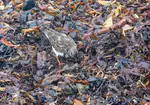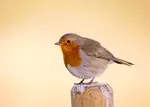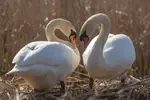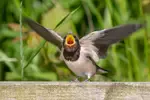- Home
- Photo Basics
- Golden Hour Photography
Golden Hour Photography Isn't Just for Pros. It’s For You, Too
Golden hour photography lets you catch birds, mammals, and landscapes in that warm, honey-coloured light around sunrise and sunset—when everything looks calmer and more alive.
In this practical guide, you’ll get field-tested timing tips, low-light camera settings, and simple scouting tactics so you can head out knowing exactly when and where that glow will appear.
You don’t need pro gear or heavy editing to get those dreamlike shots; you just need to show up for this short window of light.
By the end, you’ll see why these few minutes are not only the best time of day for your photos, but often the most peaceful part of your day too.
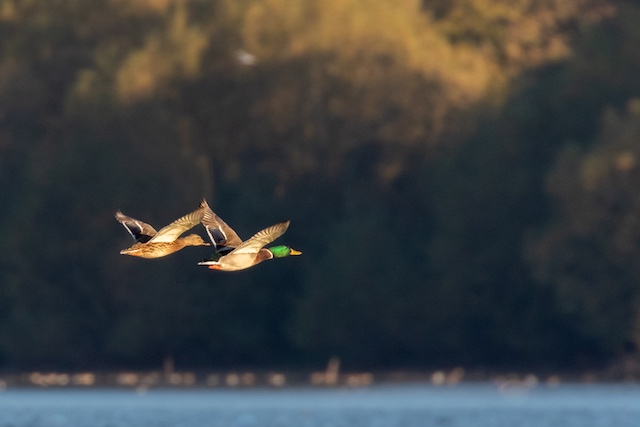
The First Step: Overcoming the Snooze Button
I know the feeling.
The alarm goes off while it’s still dark, and your warm bed feels like the most logical place in the world. The idea of trading it for what feels like a slim chance of catching the light can feel foolish.
I had that exact battle in a little cottage in Bamburgh, Northumberland. My family were sleeping soundly. But my passion, and a little bit of stubbornness, urged me out of bed. I quietly slipped out into the pre-dawn quiet.
That’s your first hurdle. Not f-stops, not composition. Just winning the argument with your pillow.
- The best tip I can give you? Don't start with a huge trip. Just step outside your own back door for five minutes as the sun rises or sets. Leave your camera inside. Just watch. See how the light touches the edge of a leaf or warms the face of a brick wall.
- We have to prove to ourselves that we can show up. By doing this we connect with the rhythm of the day and that small win gives us the confidence to try something more.
Finding Your Spot and guaranteeing a win
As I walked through the sleeping village of Bamburgh, a little flicker of doubt hit me. What if I get to the beach and the light is flat? What if I walk all this way for nothing? I had let this fear win in the past, but this day was different!
That's why I chose the castle as my subject.
This is my secret to building confidence, especially when you're just starting. Wildlife is unpredictable. Birds don't show up on command, and deer don't wait for good light. If your only goal is to find a specific animal, you're setting yourself up for potential disappointment.
But a castle? A castle is always there.
By choosing a static, reliable subject—a landmark, a unique tree, a pier, a bridge—you remove half the risk. You guarantee you will have something to photograph. You can focus solely on the light and how it transforms a subject you know will be waiting for you.
Think of it as your first step. Master the light on a subject that can't run away. Then, on a later occasion, you can take that confidence and go looking for wildlife, knowing you already have the skills to capture the moment if it arrives.
- Use a free app like The Photographer's Ephemeris to see exactly where the sun will rise and set in relation to your chosen landmark. This crucial step turns a vague hope into a concrete plan, telling you precisely where to stand and when to be there.
- You're no longer just a hopeful guesser; you're the architect of your shot. Being in the right place, at the right time, on purpose, gives you a feeling of control that is as golden as the light itself.
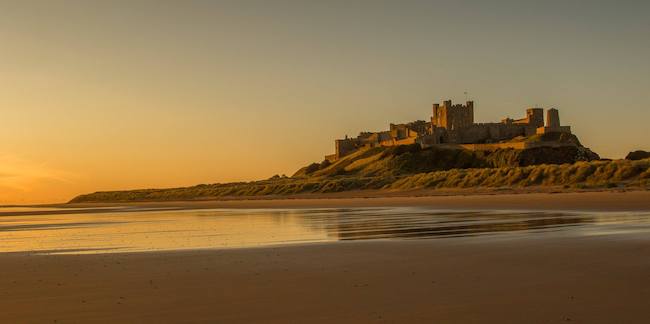 Bamburgh Castle at sunrise
Bamburgh Castle at sunriseTelling a Story With Light and Shadow
When I reached the beach, there was another photographer setting up his tripod.
We nodded, sharing the quiet understanding of why we were both there. We weren't rivals; we were pilgrims.
As the sun finally broke, it hit Bamburgh Castle. The old stones lit up, and the light reflected in the saltwater pools left by the tide. It was more beautiful than I’d hoped.
Standing there, looking at that vast scene—the castle, the sand, the sea—my goal was to capture the epic scale of it all. I wanted everything to feel sharp and in focus, from the wet sand at my feet to the castle walls in the distance.
My first instinct was just to point and shoot.
But the most powerful golden hour shots don't just show a scene; they make you feel it. The key is guiding the eye.
To achieve that sharpness I wanted I realised I would need to choose a narrow aperture but to then allow enough light in I would need to use a slower shutter speed. Now I realised why the other photographer had lugged his tripod with him!
That sharp, all-encompassing view was the right choice for the castle.
But what happens when the story isn't as epic? What happens when it's small and intimate, and you want to lift one tiny subject out of a messy background?
That’s a completely different challenge, and it needs a completely different tool. Let me take you from that beach at golden hour right back to an early morning in my own garden.
I was trying to photograph a small bird, a Dunnock, on our hedge.
The photo was a mess. The branches and leaves in the background were so distracting that the beautiful little bird was completely lost in the clutter. My photo didn't have a clear hero.
To make that Dunnock the star of the show, I needed to do the exact opposite of what I did for the castle. Instead of making everything sharp, I needed to make the background disappear into a soft, blurry glow.
- This is where you use a wide aperture (a low f-stop number like f/2.8 or f/4). This simple change tells your camera to create a very shallow depth of field, throwing the background out of focus and making your subject pop with incredible clarity.
- The feeling you get when you nail this is pure magic. You realize you now have the power to tell the camera, "Look here. This is the important part." You've moved from just taking a picture to creating a portrait.
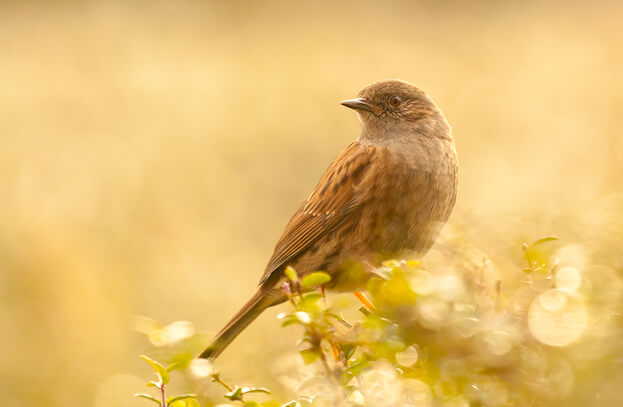 A wide aperture threw the background of this Dunnock out of focus
A wide aperture threw the background of this Dunnock out of focusCapturing the Whole Feeling (Even When Your Camera Struggles)
I remember looking at the photo of Bamburgh Castle on the back of my camera.
In the glowing pre-dawn light, my eyes could see both the colour in the sky and the details on the ancient stones. But on my little screen? The sky looked okay, but the castle was just a dark, shadowy silhouette.
I felt that pang of disappointment every photographer knows.
The camera hadn't captured the whole feeling of the scene in front of my eyes. Maybe my camera wasn't good enough?
I now realise that wasn't the case, it was just a limitation I had to learn to work around.
The secret was to capture more information than I could see on the back of the camera.
- If your camera has it, switch the image quality to "RAW." A RAW file is like the full, uncompressed story from your camera's sensor. A JPEG is just the summary. A RAW file holds all the details in those bright highlights and dark shadows, giving you amazing flexibility later.
- This frees us from the frustration of "getting it perfect in-camera." We have the power to bring our memory of the scene back to life during editing, ensuring the final image reflects what we actually saw.
The Final Touch: Making the Image Feel Like the Memory
That four-mile walk in Bamburgh left my feet sore, but the feeling of reward was immense. I had the RAW file, the full story of that morning's light safely captured on my memory card.
Back at the computer, I knew the photo on my screen was just the starting point. The final, most personal step was still to come: gently editing the image to make it truly match the incredible memory I held in my mind.
That's a story for another day.
For now, the most important work is done. It's not about sliders or software; it's about showing up. The magic of the golden hour isn't locked away in a computer; it's a daily invitation to step outside.
So please, set that alarm. Go chase the light. The results may thrill you, but I promise the feeling of just being there will change you.
Further Reading
Related Photography Tips
Low Light Wildlife Photography - Capture stunning wildlife images between dusk and dawn with essential gear tips, optimal settings, and expert advice.
Wildlife Photography in the Rain - Discover tips on keeping you and your gear dry while taking advantage of the elements to take stunning photos.
How to Edit a Wildlife Photo - An intro to learning how to edit a wildlife photo with techniques that will help your photos look their best while still appearing natural.
Related Walks & Stories
A Winter Sunrise at the Nene Washes - Discover the magic of RSPB Nene Washes in winter. See photos of Short-Eared Owls, Whooper Swans, and deer.
If the light's playing nice, try these tips for your next woodland photography walk.
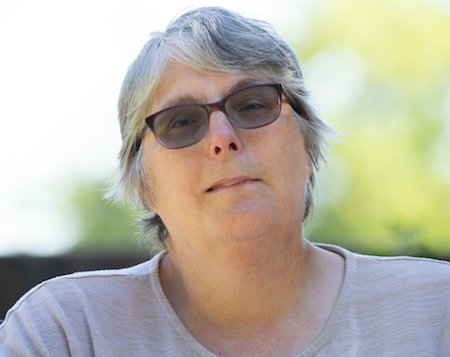
About the Author
I’m a wildlife photographer who learns on everyday walks. This site is my field notebook: practical photo tips, gentle ID help, and walk ideas to help you see more—wherever you are.
Step Behind the Wild Lens
Seasonal field notes from my wildlife walks: recent encounters, the story behind favourite photos, and simple, practical tips you can use on your next outing.

